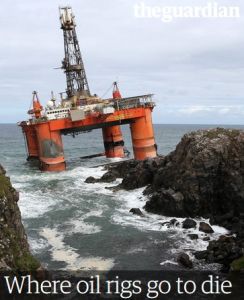Join getAbstract to access the summary!

Join getAbstract to access the summary!
Tom Lamont
Where Oil Rigs Go to Die
When a drilling platform is scheduled for destruction, it must go on a thousand-mile final journey to the breaker’s yard. As one rig proved when it crashed on to the rocks of a remote Scottish island, this is always a risky business
The Guardian, 2017
What's inside?
Disposing of oil rigs is risky business.
Recommendation
When oil rigs are no longer in service, their owners must take them somewhere for disassembly. According to Guardian reporter Tom Lamont, disposing of the world’s excess oil rigs is a highly complex and risky undertaking. For his in-depth investigative report, Lamont followed the adventurous journey of Transocean Ltd’s oil rig, the Transocean Winner, from the North Sea to its final destination in Turkey. getAbstract recommends Lamont’s informative essay to business leaders in the oil exploration and shipping industries.
Summary
About the Author
Tom Lamont is a writer for the Guardian and the Observer.

















Comment on this summary